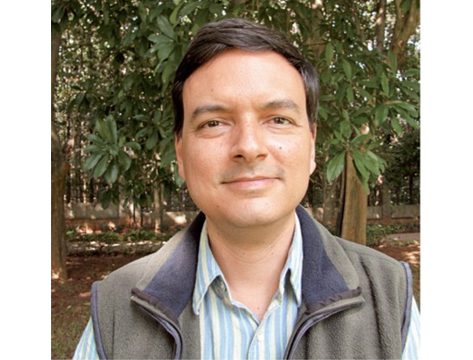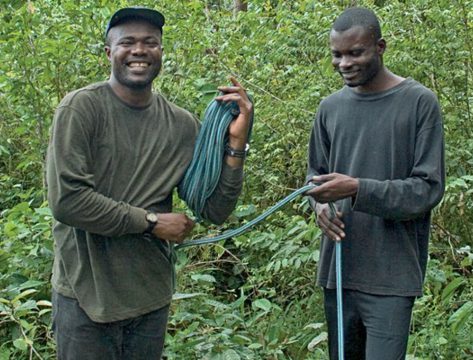We Are the Cornell Lab of Ornithology
By Pat Leonard
From the Winter 2015 issue of Living Bird magazine.
January 15, 2015One hallmark of the Cornell Lab of Ornithology has always been the easygoing partnership between professional ornithologists and everyday bird watchers. Our definition of the Lab is not confined to the people who labor within its walls here in Ithaca, New York. We think of the Lab writ large—shaped by ever-growing legions of volunteer project participants and local conservation leaders who now use the Lab’s tools and programs, working to make the world a better place for birds and people. Each individual or group we work with creates a ripple of change radiating outward from a backyard, a neighborhood, or even across an entire country. It may begin with the bird bander in Wisconsin who rescues four nestlings; with the creation of a bird garden for city kids in San Diego as part of Celebrate Urban Birds; with the dedicated biologist in the Congo using Lab technology to try to protect forest elephants; or with the Washington teacher using BirdSleuth lessons to open his student’s eyes to birds and nature and create a connection that lasts for life. Each of these people brings us a step closer to a world in which the needs of humans and the natural world are more in balance. Read on to see the faces and hear the voices of just a few of the people who make up the larger Cornell Lab community around the world and who inspire us every day.

Makeda Dread Cheatom was inspired to create an urban bird garden after discovering the Lab’s bilingual Celebrate Urban Birds project. In the garden, located in San Diego’s Balboa Park, young people learn about birds, butterflies, flowers, recycling, and other earth-friendly topics. The garden is part of the WorldBeat Center, which Makeda founded 35 years ago to unite people of many cultures through programs in art, music, and dance. Makeda has introduced the project to WorldBeat’s sister center in Tijuana, Mexico. “We were given an alley to use where we planted trees and flowers and started working with kids to try to combat the violence,” Makeda says. “It’s transformed the neighborhood.” Exposure to birds and nature is transforming the young people, too, says WorldBeat staffer Berenice Rodriguez (at left, above). “They realize, ‘I can collect data right here and have it used by a university!’” Since Celebrate Urban Birds was founded in 2007, more than 10,000 community groups like Makeda’s have partnered with the Cornell Lab to bring an awareness of birds and nature to a diverse audience.

Sam Mroz (pictures at the top) can remember exactly when his interest in birds began. Two years ago, looking for something to do one day, his mother suggested he go outside and write about nature. “We were studying birds in class that week,” Sam recalls. “I identified one robin and two Black-capped Chickadees. Ever since, I have not stopped loving and watching birds—I have seen 256 species!” After moving from the state of Washington to Massachusetts, Sam found new birds to enjoy, though the MacGillivray’s Warbler of the West is his favorite. A casual encounter took his interest in a new direction. “I met another birder on the beach, who turned out to be Kevin McGowan, an instructor at the Lab,” Sam says. “He asked me if I would like to take some of his webinars. I was thrilled, and I loved the webinars! He taught us many identification tricks you cannot find in a field guide.” Sam isn’t the only one who loves the webinars. Nearly 2,000 people worldwide have tuned in since the webinars were first offered in March 2013.

Juan Ignacio “Nacho” Areta first connected with the Lab as a graduate student in 2007 when he attended a Macaulay Library Sound Recording Workshop. Today he is a scientist with CONICET, the agency in charge of promoting science and technology in his native Argentina, and he is helping teach others how to record the sounds of nature. “Teaching others how to record has been an enriching experience,” Areta says, “not only because it took me to Colombia, Brazil, and Peru to meet passionate people who want to learn about nature’s music, but because it made me think about the way I record birds myself and the best way to explain it to others.” Areta is a founding member of Grupo FALCO, a group of ornithologists whose daunting goal is to record all the birds of South America’s Southern Cone. So far they have contributed more than 12,000 recordings to the Macaulay Library archive. “I wish to provide other people with tools to detect and identify birds to help discover important areas for conservation,” he explains. “We must preserve the habitats to preserve our birds.”

Suhel Quader is a scientist at the nonprofit Nature Conservation Foundation in Mysore, India. His group partners with others to promote citizen science in India using the Lab’s global eBird and Great Backyard Bird Count projects. “We’ve formed an informal consortium of organizations and Internet groups called Bird Count India,” Quader says. “We run a monthly eBird challenge and encourage birders to contribute their lists.” During the last Great Backyard Bird Count, India submitted more checklists than any other country outside the United States and Canada. Quader admits there’s still a long way to go because relatively few people in India are interested in birds, nature, and conservation. The result is inadequate documentation of the country’s birds. “We also don’t know how populations are changing,” Quader says. “Right now we are focused on documentation so the information can be used by our partners, such as the Indian Bird Conservation Network.”

Endangered African forest elephants have a strong defender in Congolese biologist Clement Inkamba Nkulu (above left, with assistant Russel Tsoumou). For more than a decade he has been monitoring these surprisingly elusive animals for the Wildlife Conservation Society and is now director of the Ogooué Leketi Elephant Project in the Republic of the Congo. Peter Wrege from the Lab’s Elephant Listening Project is providing training and equipment so Clements can monitor forest elephants by sound, as the Lab does in nearby Gabon. These round-the-clock recordings pick up more than elephant sounds. “We can even hear poachers’ guns, and see those sounds on the spectrograms,” says Clement. “I am now planning to learn how to analyse acoustic data collected over the past three years.” Clement also hopes to earn his Ph.D. and one day teach biology in a university to help train a new generation of conservationists.

Alice Droske of Elk Mound, Wisconsin, is the quintessential citizen scientist. For 28 years she has been contributing bird observations to Lab projects, and she is still going strong. Alice can remember when participating meant using a pencil to blacken a circle on a paper form or mailing nesting information to the Lab on an index card. Now Alice uses the Internet to report her backyard birds, as do about 200,000 fellow citizen scientists around the world. Alice is a bird bander and a volunteer at Beaver Creek Reserve in Fall Creek, Wisconsin, where she monitors American Kestrel nests. She once helped rescue four kestrel nestlings after a bear shattered their nest box. The box was repaired, the parents returned, and the nestlings survived, the happiest of outcomes. “Citizen scientists are a very important part of the puzzle,” Alice explains. “Scientists cannot be in the field like we can. We can keep them informed about what is going on in the natural world around us.”

Phil Kahler fell in love with birds when he was a kid. He hopes to get his science students turned on to the outdoors, too. After hearing about Project FeederWatch, he signed up the class. That was 20 years ago. Now, the Cornell Lab’s BirdSleuth curriculum is part of his lesson plan at Tualatin Valley Academy in Oregon, and all his seventh- and eighth-grade science students have their own eBird accounts. “It is just not possible for most schools to take students on frequent field trips to study nature,” Kahler explains, “but with birds, teachers can get nature to come to the students. BirdSleuth provides a focused approach for my students to practice using their inquiry skills.” Kahler is also a BirdSleuth Ambassador, helping other teachers share birds with their students. “Teachers need to know that no matter what their experience level is, birds can still be used in their curriculum,” says Kahler. “The most important thing is to go ahead and get started, you can learn with your students as you go.”

All About Birds
is a free resource
Available for everyone,
funded by donors like you
American Kestrel by Blair Dudeck / Macaulay Library



